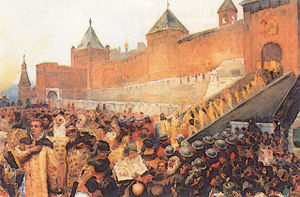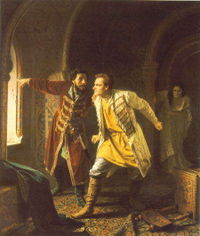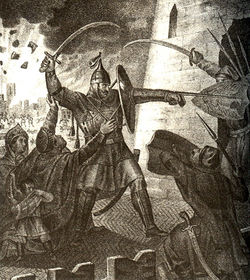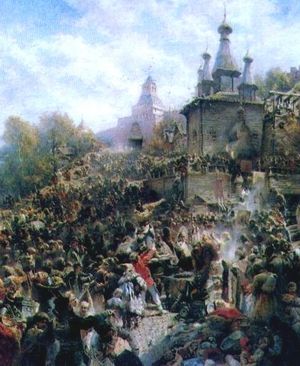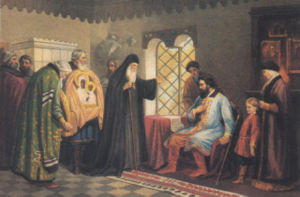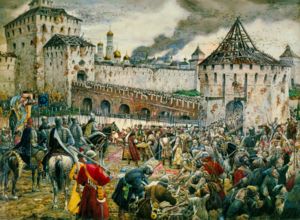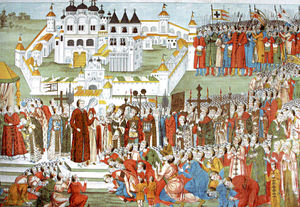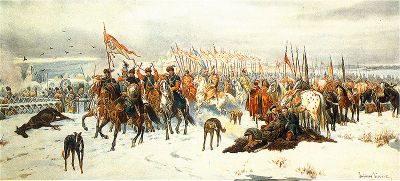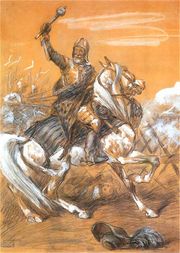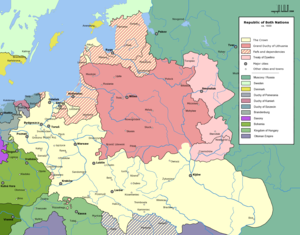Polish–Muscovite War (1605–1618)
2007 Schools Wikipedia Selection. Related subjects: Pre 1900 Military
| Dmitriads — Polish–Muscovite War of 1609–1618 | |||||||
|---|---|---|---|---|---|---|---|
 Map of the war. Important battles marked with crossed swords. |
|||||||
|
|||||||
| Combatants | |||||||
| Polish-Lithuanian Commonwealth | Muscovite Russia | ||||||
| Polish-Muscovite War (1605–1618) |
|---|
| Bely • Dobrynichi • Trinity Monastery • Smolensk • Tsaryovo Zaimishche • Klushino • Mozhaysk • 1st Moscow • 2nd Moscow |
| Polish-Russian Wars |
|---|
| Kiev Expedition – Muscovite-Lithuanian – Livonian – 1605–18 – Smolensk – 1654–67 – Bar Confederation – 1792 – Kościuszko Uprising – November Uprising – January Uprising – Polish-Soviet – 1939 |
The Polish–Muscovite War (1605–1618) is the name of the series of wars (1605–1618) between the Polish-Lithuanian Commonwealth and Russia (or Muscovy), in the background of the Russian dynastic crisis known as the Time of Troubles (1598–1613). The sides and their goals changed several times during this conflict: the Polish-Lithuanian Commonwealth was not formally at war with Muscovy until 1609, and various Muscovite factions fought among themselves, allied with the Commonwealth and other countries or fighting against them. Sweden also participated in the conflict during the course of the Ingrian War (1610–1617), sometimes allying itself with Muscovy, and other times fighting against it. The goals of the various factions changed as well, from minor border adjustment by influencing the choice of Russian tsar to creating a new state by forming a union between the Commonwealth and Muscovy.
The war can be divided into four stages. In the first stage, known to Poles as the Dymitriads ( Polish: Dymitriady), certain Commonwealth szlachta magnates (high ranking nobility), encouraged by some Muscovite boyars — but without the official consent of the Polish king Sigismund III Vasa (Polish: Zygmunt III Waza) — attempted to exploit Muscovite weakness and intervene in its civil war. They thus supported the tsar pretenders False Dmitriy I and later False Dmitriy II (hence the Polish name of the war, the Dymitriads) against the crowned tsars, Boris Godunov and Vasili Shuiski. The first Dymitriad began in 1605 and ended in 1606 with the death of False Dmitri I. The second Dymitriad in 1607 and lasted until 1609, when Tsar Shuisky made a military alliance with Sweden. In response to this alliance, the Polish King Sigismund III decided to intervene officially and to declare war upon Muscovy, aiming to weaken Sweden's ally and to gain territorial concessions.
After early Commonwealth victories ( battle of Klushino), which culminated in Polish forces entering Moscow in 1610, Sigismund's son, Prince Władysław, was briefly elected tsar. However, soon afterwards, Sigismund decided to seize the Russian throne for himself. This alienated the pro-Polish supporters among the boyars, who could accept the moderate Władysław, but not the pro- Catholic and anti- Orthodox Sigismund. Subsequently, the pro-Polish Muscovite faction disappeared, and the war resumed in 1611, with the Poles losing control of Moscow but capturing the important city of Smolensk (see Siege of Smolensk (1609–11)). However, due to internal troubles in both the Commonwealth and Muscovy, little military action occurred between 1612 and 1617, when Sigismund made one final and failed attempt to conquer Muscovy. The war finally ended in 1618 with the Treaty of Dywilino, which granted the Commonwealth certain territorial concessions, but not control over Muscovy. Muscovy thus emerged from the war with its independence unscathed.
Names of the war
The Polish-Muscovite War (1605–1618) is often referred to by other names, such as the Polish–Russian War of 1605–1618. The war is also divided into the First Dymitriad (1605–1606) and Second Dymitriad (1607–1609) and the Polish-Muscovite (Russian) War (1609–1618), which can subsequently be divided into two wars of 1609–1611 and 1617–1618. In Polish historiography, the wars are usually referred to as the Dymitriady, and may or may not include the 1617–1618 campaign, which is sometimes referred to as Chodkiewicz [Muscovite] campaign. According to Russian historiography, the chaotic events of the war fall into the " Time of Troubles" (смутное время). The conflict with Poles is commonly called the Polish invasion, Polish intervention, or more specifically the Polish intervention of the early-17th century.
Prelude to the war
In the late 16th century and early 17th century, Muscovy was in a state of political and economic crisis. After the death of tsar Ivan IV Grozny (Ivan the Terrible) in 1584, and the presumed death of his son Dmitriy in 1591, several factions competed for the tsar's throne. In 1598 the throne was seized by Boris Godunov, who had possibly been an orchestrator of Dmitriy's assassination. Godunov, however, did not manage to crush all opposition to his rule.
In late 1600 a Polish-Lithuanian diplomatic mission led by Great Lithuanian Chancellor Lew Sapieha with Eliasz Pielgrzymowski and Stanisław Warszycki arrived in Moscow and proposed an alliance between the Commonwealth and Muscovy, which would include a future personal union. They proposed that after one monarch's death without heirs, the other would become the ruler of both countries. However, Tsar Godunov declined the union proposal and settled only on extending the Treaty of Jam Zapolski, ending the 16th century Muscovite wars by 22 years (to 1622).
Sigismund and the Polish magnates knew full well that the Commonwealth was not capable of any serious invasion of Muscovy; the Polish army was too small, its treasury always empty, and the war lacked popular support. However, as the situation in Muscovy deteriorated, Sigismund and many Commonwealth magnates, especially those with estates and forces near the Muscovite border, began to look for a way to profit from the chaos and weakness of their eastern neighbour. This proved easy, as in the meantime many Muscovite boyars, disgruntled by the ongoing civil war, tried to entice various neighbors of Muscovy, including the Polish-Lithuanian Commonwealth, into intervening. Some of them looked to their own profits, trying to organize support for their own ascension to the Russian throne (as Boris Godunov had done, and Mikhail Feodorovich Romanov would in the near future). Others looked to their western neighbour, the Commonwealth, and its attractive Golden Freedoms, and together with some Polish visionaries planned for some kind of union between those two states. Yet others tried to tie their fates with that of Sweden in what became known as the De la Gardie Campaign and the Ingrian War.
The advocates of a Polish-Lithuanian-Muscovite Commonwealth (sometimes referred to as unia troista) proposed a union involving a common foreign policy and military; the right of all citizens to chose the place where they would live, to buy landed estates, and to marry each other; the removal of barriers for trade and transit; the introduction of a single currency; increased religious tolerance in Muscovy (especially the right to build churches of non-Orthodox faiths, since in Poland Orthodox churches had already been allowed to be built for many years); and the sending of boyar children for an education in more developed Polish academies (like the Jagiellonian University). However, this project never gained much support; many boyars feared that Poland-Lithuania would dominate Muscovy and opposed anything that threatened Muscovite culture, especially the policies of religious tolerance, intermarriage and education in Polish schools.
The First Dymitriad (1605-1606)
For most of the 1600s, Sigismund III was occupied with internal problems of his own, like the civil war in the Commonwealth (the rokosz of Zebrzydowski) and the wars with Sweden and in Moldavia. However, when the pretender False Dmitriy I appeared in Poland in 1603, he soon found enough support among powerful magnates such as Michał Wiśniowiecki, Lew and Jan Piotr Sapieha, who provided him with funds for a campaign against Godunov. Commonwealth magnates looked forward to material gains from the campaign and control over Dmitriy. In addition, both Polish magnates and Muscovite boyars advanced plans for a union between the Commonwealth and Russia, similar to the one Lew Sapieha had discussed in 1600 (when the idea had been dismissed by Godunov). Finally, the Holy See saw in Dmitriy a tool to spread Catholicism eastwards, and after promises of a Polish-Muscovite Catholic union waging a war on the Ottoman Empire, Jesuits provided him with some funds and education. Sigismund, although he declined to support Dmitriy officially with the full might of the Commonwealth, was always happy to support pro-Catholic initiatives and provided him with the sum of 4,000 zlotys–enough for a few hundred soldiers. Nonetheless, some of Dmitriy's supporters, especially among those involved in the rokosz, actively worked to have Dmitriy replace Sigismund. In exchange, in June 1604 Dmitriy promised the Commonwealth 'half of Smolensk territory'. However, many people were skeptical about the future of this endeavor. Jan Zamoyski, opposed to most of Sigismund's policies, later referred to the entire False Dmitriy I affair as a comedy worth of Plautus or Terentius.
When Boris Godunov heard about the pretender, he claimed that the man was just a runaway monk called Grigory Otrepyev (born Yury Otrepyev–Grigory was the name given to him at the monastery), although on what information he based this claim is unclear. Regardless, his support began to wane, especially when he tried to spread counter-rumors. Some of the Russian boyars also claimed to accept Dmitriy's claim. Such support gave them legitimate reasons not to pay taxes to Godunov.
Dmitriy attracted a number of followers, formed a small army, and, supported by approximately 3500 soldiers of the Commonwealth magnates' private armies and the mercenaries bought by Dmitriy's own cash, rode to Russia in June 1604. Some of Godunov's other enemies, including approximately 2,000 southern Cossacks, joined Dimitry's forces on his way to Moscow. Dmitriy's forces fought two engagements with reluctant Russian soldiers; Dimitry's army won the first at Novhorod-Siversky (Nowogród Siewierski, Novgorod-Seversky) soon capturing Chernihiv (Czernihów, Chernigov), Putyvl (Putivl), Sevsk, and Kursk, but badly lost the second battle at Dobrynichi and nearly disintegrated. Dmitriy's cause was only saved by the news of the death of Tsar Boris.
The sudden death of Tsar Boris Godunov on April 13, 1605 removed the main barrier to Dimitriy's further progress. Russian troops began to defect to Dmitriy's side, and on June 1 boyars in Moscow imprisoned the newly-crowned tsar, Boris's son Feodor II, and the boy's mother, later brutally murdering them. On 20 June the impostor made his triumphal entry into Moscow, and on the 21st of July he was crowned tsar by a new patriarch of his own choosing, the Greek Cypriot Patriarch Ignatius, who as bishop of Ryazan had been the first church leader to recognize Dmitriy as tsar. The alliance with Poland was furthered by Dimitriy's marriage ( per procura in Cracow) with the daughter of Jerzy Mniszech, Marina Mniszech, a Polish noblewoman with whom Dmitriy had fallen in love while in Poland. The new tsarina outraged many Russians by refusing to convert from Catholicism to Russian Orthodox faith. Commonwealth king Sigismund was a prominent guest at this wedding. Marina soon left to join her husband in Moscow, where she was crowned a tsarina in May.
However, Dmitriy's position was weak. Many boyars felt they could gain more influence, even the throne, for themselves, and many were still wary of Polish cultural influence. The very Golden Freedoms, declaring all nobility equal, that were supported by lesser nobility, threatened the most powerful of the boyars. Thus the boyars, headed by Prince Vasily Shuisky, began to plot against Dmitriy and his pro-Polish faction, accusing him of homosexuality, spreading Roman Catholicism and Polish customs, and selling Muscovy to Jesuits and the Pope. They gained popular support, especially as Dmitriy was visibly supported by few hundred irregular Commonwealth forces, which still garrisoned Moscow, and often engaged in various criminal acts, angering the local population.
On the morning of May 17, 1606, about two weeks after the marriage, conspirators stormed the Kremlin. Dmitriy tried to flee through a window but broke his leg in the fall. One of the plotters shot him dead on the spot. At first the body was put on display, but it was later cremated; the ashes were shot from a cannon in the direction of Poland. Dmitriy's reign had lasted a mere ten months. Vasili Shuisky took his place as Tsar. About five hundred of Dmitriy's Commonwealth supporters were killed, imprisoned or forced to leave Muscovy.
The Second Dymitriad (1607-1609)
Tsar Vasili Shuiski was unpopular and weak in Russia and his reign was far from stable. He was perceived as anti-Polish; he had led the coup against the first False Dmitriy, killing over 500 Polish soldiers in Moscow and imprisoning a Polish envoy. The civil war raged on, as in 1607 the False Dmitriy II appeared, again supported by some Polish magnates and 'recognized' by Marina Mniszech as her first husband. This brought him the support of the magnates of the Polish-Lithuanian Commonwealth who had supported False Dmitriy I before. Adam Wiśniowiecki, Roman Różyński, Jan Piotr Sapieha decided to support the second pretender as well, supplying him with some early funds and about 7500 soldiers. The pillaging of his army, especially of the infamous Lisowczycy mercenaries led by Aleksander Lisowski, contributed to the infamous placard in Sergiyev Posad (Zarajsk): "three plagues: typhus, Tatars, Poles". In 1608 together with Aleksander Kleczkowski, Lisowczycy, leading a few hundred Don Cossacks (kozacy dońscy), ragtag szlachta and mercenaries defeated the army of tsar Vasili Shuisky led by Zakhary Lyapunov and Ivan Khovansky near Zaraysk and captured Mikhailov and Kolomna. Then Lisowczycy advanced towards Moscow, but was defeated at Niedźwiedzi Bród, losing most of its plunder. When Jan Piotr Sapieha failed to win the siege of Troitse-Sergiyeva Lavra, Lisowczycy retreated to the vicinity of Rakhmantsevo. Soon, however, came successes (pillages) at Kostroma, Soligalich and some other cities.
Dmitriy speedily captured Karachev, Bryansk and other towns. He was reinforced by the Poles, and in the spring of 1608 advanced upon Moscow, routing the army of Tsar Vasily Shuisky at Bolkhov. Dmitriy's promises of the wholesale confiscation of the estates of the boyars drew many common people to his side. The village of Tushino, twelve versts from the capital, was converted into an armed camp, where Dmitriy gathered his army. His forces initially included 7000 Polish soldiers, 10,000 Cossacks and 10,000 other soldiers, including former members of the failed rokosz of Zebrzydowski but his force grew gradually in power, and soon exceeded 100,000 men. He raised another illustrious captive, Feodor Romanov, to the rank of patriarch, enthroning him as Patriarch Filaret, and won the allegiance of the cities of Yaroslavl, Kostroma, Vologda, Kashin and several others. However, his fortunes were soon to reverse, as the Commonwealth decided to take a more active stance in the Muscovite civil wars.
Polish-Muscovite War (1609-1618)
Polish victories (1609-1610)
In 1609 the rokosz of Zebrzydowski ended when tsar Vasili signed a military alliance with Charles IX of Sweden that year (on 28 February 1609). The Commonwealth king Sigismund III, whose primary goal was to regain the Swedish throne, got permission from the Sejm to declare war on Muscovy. He viewed it as an excellent opportunity to expand the Commonwealth's territory and sphere of influence, with hopes that the eventual outcome of the war would Catholicize Orthodox Russia (in this he was strongly supported by the Pope) and enable him to defeat Sweden. This plan also allowed him to give a purpose to the numerous restless former supporters of Zebrzydowski, luring them with promises of wealth and fame awaiting members of the campaign beyond the Commonwealth's eastern border. A book published that year by Paweł Palczwski, Kolęda moskiewska, compared Muscovy to the Indian empires of the New World, full of golden cities and easy to conquer. Further, some Muscovite boyars assured him of their support by offering the throne to Prince Władysław, son of Sigismund III. Previously, Sigismund III had been unwilling to commit the majority of Polish forces or his time to the internal conflict in Muscovy, but in 1609 those factors made him re-evaluate and drastically change his policy.
Although many Polish nobles and soldiers were fighting for the second False Dmitriy at the time, Sigismund III and the troops under his command did not act in support of Dimitriy's to the throne–Sigismund III wanted Russia himself. The entry of King Sigismund III into Muscovy caused the majority of False Dmitriy II's Polish supporters to desert him and contributed to his defeat. A series of subsequent disasters induced False Dmitriy II to flee his camp disguised as a peasant and to go to Kostroma together with Marina. Dimitriy also made another unsuccessful attack on Moscow, and, supported by the Don Cossacks, recovered a hold over all south-eastern Russia. However, he was killed, while half drunk, on the 11th of December 1610 by a Qasim Tatar princeling Pyotr Urusov, whom Dimitriy had flogged on a previous occasion.
A Commonwealth army under the command of hetman Stanisław Żółkiewski, who was generally opposed to this conflict, but could not disobey king's orders, crossed the border, and on 29 September 1609 laid siege to Smolensk, an important city that Russia had captured from Lithuania in 1514. Smolensk was manned by fewer than 1,000 Russian men commanded by the voivod Mikhail Shein, while Żółkiewski commanded 12,000 troops. However, Smolensk had one major advantage: the previous tsar, Boris Godunov, had sponsored the fortification of the city with a massive fortress completed in 1602. The Poles found it impenetrable; they settled into a long siege, firing artillery into the city, attempting to tunnel under the moat, and building earthen ramparts, remnants of which can still be seen today. The siege lasted 20 months before the Poles succeeded in taking the fortress.
Not all of the Commonwealth attacks were successful. An early attack, led by hetman Jan Karol Chodkiewicz with 2,000 men, ended in defeat when the unpaid Commonwealth army mutinied and compelled their leader to retreat through the heart of Russia and back to Smolensk. Not until the crown prince, Władysław, arrived with tardy reinforcements did the war assume a different character. In the meantime, Lisowczycy took Pskov in 1610 and clashed with the Swedes operating in Russia during the Ingrian War.
All the time, several different visions of the campaign and political goals clashed in the Polish camp. Some of the former members of the rokosz of Zebrzydowski, opponents of Sigismund, actually advanced proposals to have Sigismund dethroned and Dmitriy, or even Shuisky, elected king. Żółkiewski, who from the beginning opposed the invasion of Muscovy, came into conflict with King Sigismund III over the scope, methods and goal of the campaign. Żółkiewski represented the traditional views of Polish nobility, the szlachta, which did not support waging aggressive and dangerous wars against a strong enemy like Muscovy. Thus Żółkiewski favoured the plans for peaceful and voluntary union, much like that with Lithuania. Żółkiewski offered Russian boyars rights and religious freedom, envisioning an association resulting in the creation of the Polish-Lithuanian-Muscovite Commonwealth. To that end, he felt that Moscow's cooperation should be gained via diplomacy, not force. Sigismund III, however, did not want to engage in political deals and compromises, especially when these had to include concessions to the Orthodox Church. Sigismund was a vocal, almost fanatical supporter of the Catholic Church and counter-reformation, and believed that he could win everything and take Moscow by force, and then establish his own rule along with the rule of the Roman Catholic Church.
Poles in Moscow (1610)
On 31 January 1610 Sigismund received a delegation of boyars opposed to Shuisky, who asked Władysław to become the tsar. On 24 February Sigismund sent them a letter in which he agreed to do so, but only when Moscow was at peace.
Hetman Żółkiewski, whose only other choice was mutiny, decided to follow the king's orders and left Smolensk in 1610, leaving only a smaller force necessary to continue the siege. With Cossack reinforcements, he marched on Moscow. However, as he feared and predicted, as the Polish-Lithuanian forces pressed eastwards, ravaging Muscovite lands, and as Sigismund's lack of willingness to compromise became more and more apparent, many supporters of the Poles and of the second False Dmitriy left the pro-Polish camp and turned to Shuiski's anti-Polish faction.
Russian forces under Grigory Voluyev were coming to relieve Smolensk and fortified the fort at Tsaryovo-Zaimishche (Carowo, Cariewo, Tsarovo-Zajmiszcze) to bar the Poles' advance on Moscow. The Siege of Tsaryovo began on June 24. However, the Russians were not prepared for a long siege and had little food and water inside the fort. Voluyev sent word for Dmitriy Shuisky (Tsar Shuiski's brother) to come to their aid and lift the siege. Shuiski's troops marched for Tsaryovo, not by the direct route, but round-about through Klushino, hoping to come to Tsaryovo by the back route. Shuyski received aid from Swedish forces under the command of Jacob Pontusson De la Gardie.
Żółkiewski learned of Shuiski's relief force and divided his forces to meet Muscovite forces before they came to Tsaryovo and lifted the siege. He left at night so that Voluyev would not notice his absence. The combined Muscovite and Swedish forces were defeated in on July 4 1610 at the battle of Klushino (Kłuszyn), where 5,000 Polish elite cavalry, the hussars under hetman Stanisław Żółkiewski, defeated the numerically superior Russian army of about 35,000-40,000 soldiers. This giant and surprising defeat of the Muscovite forces shocked everyone and opened a new phase in the current conflict.

After the news of Klushino spread, support for tsar Shuiski almost completely disappeared. Żółkiewski soon convinced the Muscovite forces at Tsaryovo, which were much stronger than the ones at Kłuszyn, to capitulate and to swear an oath of loyalty to Władysław. Then he incorporated them into his forces and moved towards Moscow. In August 1610 many Muscovite boyars accepted that Sigismund III was victorious and that Władysław could become the next tsar if he converted to Eastern Orthodoxy. The Russian Duma voted for Tsar Shuiski to be removed from the throne. Shuiski's family, including the tsars, were captured, and Shuiski was reportedly taken to a monastery, forcibly shaved as a monk, and compelled to remain at the monastery under guard. He was later sent to Warsaw, as a kind of war trophy, and eventually died in Gostyn.
Shortly after Shuiski was removed, both Żółkiewski and the second False Dmitri arrived at Moscow with their separate armies. It was a tense moment, filled with the confusion of the conflict. Various pro- and anti-Polish, Swedish and domestic boyar factions vied for the temporary control of the situation. The Muscovite army and the people themselves were unsure if this was an invasion and that they should close and defend the city, or if it was a liberating force that they should allow in and welcome as allies. After a few skirmishes, the pro-Polish faction gained dominance, and the Poles were allowed into Moscow. The boyars opened Moscow's gates to the Polish troops and asked Żółkiewski to protect them from anarchy. The Moscow Kremlin was then garrisoned by Polish troops commanded by Aleksander Gosiewski. On 27 July a treaty was signed between the boyars and Żółkiewski promising the Muscovite boyars the same vast privileges the Polish szlachta had, in exchange for them recognising Władysław, son of Sigismund III, as the new tsar. However, Żółkiewski did not know that Sigismund, who remained at Smolensk, already had other plans.
In the meantime, Żółkiewski and the second False Dmitriy, formerly reluctant allies, began to part ways. The second False Dmitriy had lost much of his influence over the Polish court, and Żółkiewski would eventually try to drive Dmitriy from the capital. Żółkiewski soon began manoeuvring for a tsar of Polish origin, particularly the 15-year old Prince Władysław. Previously during the Time of Troubles, the boyars had offered the throne to Władysław at least twice, in the hopes of having the liberal Polish-Lithuanian Commonwealth end the despotic rule of their current tsars. Through Żółkiewski's work, the pro-Polish factions among the boyars (composed of knyazes Fyodor Mstislavsky, Vasily Galitzine, Fyodor Sheremetev, Daniil Mezetsky and diaks Vasily Telepnyov and Tomiło Łagowski gained dominance and once again a majority of the boyars said that they would support Władysław for the throne, if he converted to Orthodoxy and if Poland-Lithuania returned the fortresses that they had captured in the war.
However, Sigismund, supported by some of the more devout szlachta, was completely opposed to the conversion of the prince. From that point the planned Polish-Lithuanian-Muscovite union began to fall apart. Offended and angered by Sigismund, the boyars dragged their feet on supporting Władysław–they were divided between electing Vasily Galitzine, Michael Romanov (also 15 years old), or the second False Dmitriy. Żółkiewski acted quickly, making promises without the consent of the still-absent king, and the boyars elected Władysław as the new tsar. Żółkiewski had the most prominent of the opponents, Fyodor Romanov, Michael's father and the patriarch of Moscow, exiled from Russia in order to secure Polish support. After the election of Władysław as tsar, the second False Dmitriy fled from Tushino, a city near Moscow, to his base at Kaluga. However, his position was precarious even there, and he was killed on December 20 by one of his own men. Marina Mniszech, though, was pregnant with the new "heir" to the Russian throne, Ivan Dmitriyevich, and she would still be a factor in Muscovite politics until her eventual death in 1614.
However, Władysław faced further opposition from a seemingly unlikely party: his father. When Żółkiewski returned to meet Sigismund at Smoleńsk in November of that year, Sigismund III changed his mind and decided that he could gain the Russian throne for himself. A majority of the Russians opposed the move, especially as Sigismund didn't hide his intent to Catholicize Muscovy. Żółkiewski found himself in an awkward position–he had promised the boyars Prince Władysław to keep the Russian throne for Poland, and he knew that they would not accept King Sigismund III, who was unpopular throughout Russia. However, he also had to explain this to his king, who was convinced, from his conquests in the west, of his popularity in Russia. Eventually, Żółkiewski, disappointed with Sigismund, returned to Poland. King Sigismund III eventually compromised; he decided that he would allow his son to take the throne and that he would rule as regent until Władysław came of age. Thus, he required that the boyars who submitted and swore allegiance to Prince Władysław would also have to swear an oath to him. The boyars were more resistant to this request, and support for the Poles eroded fast. Władysław was never able to take real power, and the war soon resumed. Sigismund and Władysław left the city for safer ground as tensions grew, and the small Polish garrison at the Kremlin soon became isolated and subject to increased hostility, as more and more of the formerly pro-Polish boyars began to change factions. The Polish forces outside Moscow under the command of Jan Piotr Sapieha clashed with the growing anti-Polish Russian forces of the so called First Volunteer Army, led by Prokopy Lyapunov.
In the meantime, the siege of Smolensk continued, even as Władysław was named tsar of Russia and cities and forts throughout the area swore allegiance to the Poles. However, Sigismund III required that Smolensk not only swear allegiance, but open its gates to the Poles, which the Russians refused to do. Żółkiewski fortified Moscow with his army, and returned to King Sigismund III, who had remained at Smolensk while Żółkiewski negotiated in Moscow. The largest tunneling project at Smolensk came in December 1610; however, the Poles only managed to destroy more of the outer wall–the inner wall remained intact. The siege continued. At one point, the Polish guns breached the outer wall and the voivode of Braclaw (Bracław) ordered his soldiers to rush in; however, the Russians had predicted where the breach would occur and had fortified that part of the wall with additional men. Both troops were slaughtered, and the Poles were eventually beaten back.
The war resumes (1611)
A 1611 uprising in Moscow against the Polish garrison marked the end of Russian tolerance for the Commonwealth intervention. The citizens of Moscow had voluntarily participated in the coup in 1606, killing 500 Polish soldiers. Now, ruled by the Polish, they once again revolted. The Moscow burghers took over the munition store but Polish troops defeated the first wave of attackers, and the fighting resulted in a large fire that consumed part of Moscow. From July onward the situation of the Commonwealth forces became grave, as the uprising turned into a siege of the Polish-held Kremlin. Reportedly, the Poles had imprisoned the leader of the Orthodox Church, Patriarch Hermogenes. When the Russians attacked Moscow, the Poles ordered him, as the man with the most authority with the Russians at the time, to sign a statement to call off the attack. Hermogenes refused, and was starved to death. The Polish Kremlin garrison then found itself besieged.
In the meantime, in late 1611, prince Dmitry Pozharsky was asked to lead the public opposition against the Poles, organized by the merchants' guild of Nizhny Novgorod, with the respected town butcher (literally, a meat-trader) Kuzma Minin overseeing the handling of the funds donated by the merchants to form create the Second Volunteer Army (Russian: Второе народное ополчение). When part of the Polish army mutinied in January 1612 due to unpaid wages. and retreated from Muscovy towards the Commonwealth, the forces of the Second Volunteer Army strengthened the other anti-Polish Russian forces in Moscow. The 9,000-strong Polish army under hetman Jan Karol Chodkiewicz attempted to lift the siege and clashed with Muscovite forces, attempting to break through to Polish forces in the Kremlin on 1 September. The Polish forces used cavalry attacks in the open field, exercising tactics that were new to them: escorting a mobile tabor fortress through the city. After early Polish successes, the Muscovites' Cossack reinforcements had forced Chodkiewicz's forces to retreat from Moscow.
Russian reinforcements under prince Pozharsky eventually starved the Commonwealth garrison (there were reports of cannibalism) and forced its surrender on the 1 November (though some sources give 6 November or 7 November) after the 19 month siege. A historian (Parker) writes vividly of the Polish soldiers: "First they ate grass and offal, then they ate each other, and the survivors finally surrendered. The Moscow Kremlin fell on 6 November 1612." On November 7, the Polish soldiers withdrew from Moscow. Although the Commonwealth negotiated a safe passage, the Russian forces massacred half of the former Kremlin garrison forces as they left the fortress. Thus, the Russian army recaptured Moscow.
On June 2, 1611 Smolensk had finally fallen to the Poles. After enduring 20 months of siege, two harsh winters and dwindling food supplies, the Russians in Smolensk finally reached their limit as the Polish-Lithuanian troops broke through the city gates. The Polish army, advised by the runaway traitor Andrei Dedishin, discovered a weakness in the fortress defenses and on 13 June 1611 Cavalier of Malta Bartłomiej Nowodworski inserted a mine into sewer canal. The explosion created a large breach in the fortress walls. Jakub Potocki was the first on the walls. The fortress fell on the same day. The remaining Russian soldiers took refuge in a cathedral and blew themselves up with stores of gunpowder to avoid death at the hands of the invaders. Although it was a blow to lose Smolensk, the defeat freed up Russian troops to fight the Commonwealth in Moscow, and the Russian commander at Smolensk, Mikhail Borisovich Shein, was considered a hero for holding out as long as he had. He was captured at Smolensk and remained a prisoner of Poland-Lithuania for the next 9 years.
A new respite (1612-1617)
After the fall of Smolensk, the Polish-Muscovite border remained relatively quiet for the next few years. However, no official treaty was yet signed. Sigismund, criticized by the Sejm (the Polish parliament made up of the szlachta, who were always reluctant to levy taxes upon themselves to pay for any military force) for his failure to keep Moscow, received little funding for the army. This led to a mutiny of the Polish regular army ( wojsko kwarciane), or rather to the specific semi-legal form of mutiny practiced in the Commonwealth: a konfederacja (confederatio). The resulting konfederacja rohaczewska was considered the largest and most vicious of the soldiers' konfederacja's in the history of the Commonwealth, and it pillaged Commonwealth territories from 1612 until the most rebellious of the konfederate's were defeated on 17 May 1614 at the Battle of Rohatyn, whereupon the rest received their wages. The leader of the konfederacja, Jan Karwacki, was captured and sent in chains by the future hetman Stanisław Koniecpolski to his mentor, hetman Żółkiewski, and later executed in Lwów. The Ottoman Empire further criticized Sigismund because the Cossacks in the Ukraine once again had begun to make unsanctioned raids into Turkish territory. Thus, Poland-Lithuania got no support from the Ottoman Empire in its war.
In the meantime, the Russian Time of Troubles was far from over, and Muscovy had no strength to take advantage of the Commonwealth's weakness. On February 21, 1613 the Zemsky Sobor ("assembly of the land") named Michael Romanov, now the 17-year old son of Fyodor Romanov, the new tsar. Fyodor, now installed as Patriarch Filaret, was a popular boyar and patriarch of Moscow, one of several boyars who vied to gain control of the Muscovite throne during the Time of Troubles. The Romanovs were a powerful boyar family; Michael's great-aunt (the sister of his grandfather) was Anastasia Romanovna, the wife of Ivan the Terrible. However, the new tsar had many opponents. Marina Mniszech tried until her death in 1614 to install her child as Tsar of Russia; various boyar factions still vied for power, trying to unseat the young Tsar Michael; and Sweden intervened in force, trying to gain the throne for Duke Carl Philip, even succeeding for a few months. However, Philip received even less support then Władysław, and the Swedes were soon forced to retreat from Russia.
While both countries were shaken by internal strife, many smaller factions thrived. Polish Lisowczycy mercenaries, who were essential in the defense of Smoleńsk in 1612, when most of regulars (wojsko kwarciane) mutinied and joined the konfederacja rohatynska, were content to guard the Polish-Muscovite border against Muscovite incursions for the next three years. However, in 1615 Aleksander Józef Lisowski gathered many outlaws and invaded Muscovy with 6 chorągiew of cavalry. He besieged Bryansk and defeated the relief force of few thousand soldiers under Prince Yuri Shakhovskoy near Karachev. Then Lisowski defeated the front guard of a force several times larger then his own, under the command of knyaz Dmitry Pozharsky, who decided to defend instead of attack and fortified his forces in a camp. Lisowczycy broke contact with his forces, burned Belyov and Likhvin, took Peremyshl, turned north, defeated the Muscovite army at Rzhev, proceeded north towards Kashin, burned Torzhok, and, heavy with loot returned to Poland without any further opposition from Muscovite forces. Lisowski and his forces remained at the Polish-Muscovite border until autumn 1616, at which point Lisowski suddenly fell ill and died on 11 October. The formation was then known as Lisowczycy. Despite the death of Lisowski, his forces remained a significant threat: in 1616 they captured Kursk and defeated Russian forces at Bolkhov.
The final stage (1617-1618)
Eventually the Commonwealth Sejm voted to raise the funds necessary to resume large scale military operations. Sigismund's and Władysław's final attempt to gain the throne was a new campaign launched on 6 April 1617. Władysław was the nominal commander, but it was hetman Chodkiewicz who had actual control over the army. In October, the towns of Dorogobuzh (Drohobuż, Drohobycz) and Vyazma (Wiaźma) surrendered quickly, recognizing Władysław as the tsar. However, the Commonwealth forces suffered defeats between Vyazma and Mozhaisk, and Chodkiewicz's plans for a counterattack and an advance to Moscow failed. Władysław did not have enough forces to advance to Moscow again, especially because the Russian support for the Poles was all but gone by that time. In response to Władysław's invasion, the burghers of Smolensk revolted against Polish rule, and the Polish troops had to fight their way back as they retreated from the city. However, in 1617 Polish forces, besieged in Smoleńsk by Russian forces, were relieved by Lisowczycy, when Muscovite forces retreated to Biała soon after receiving news that Lisowczycy, then commanded by Stanisław Czapiński, had appeared in the area. Those were the last spasms of the war. Negotiations began and a peace treaty was signed in 1618.
Aftermath
In the end, Sigismund did not succeed in becoming tsar or in securing the throne for Władysław, but he was able to expand the Commonwealth's territory. On 11 December 1618 the Truce of Deulino (also known as Treaty of Dywilino), which concluded the Dymitriad's war, gave the Commonwealth control over some of the conquered territories, including the territories of Chernihiv (Czernihów) and Severia (Siewiersk) and the city of Smolensk, and proclaimed a 15-year truce. Władysław refused to relinquish his claim to the Russian throne, even though Sigismund had already done so. While the Commonwealth gained some territories, in terms of money and lives it was a very costly victory.
In 1632 the Truce of Deulino expired, and hostilities immediately resumed in the course of a conflict known as the Smolensk War. This time the war was started by the Russians, who tried to exploit the Commonwealth's suspected weakness after Sigismund III's death. However, they failed to regain Smolensk, and accepted the Treaty of Polanowo in 1634. The Russians had to pay 20,000 rubles to the Poles, but Władysław relinquished his claim to the Muscovite throne and recognized Michael as the legitimate tsar of Russia, returning the Russian royal insignia as well.
Modern legacy
The story of Dymitriads and False Dimitris proved useful to the future generations of rulers and politicians in Poland and Russia, and a distorted version of the real events gained much fame in Russia, as well as in Poland. In Poland the Dmitriads campaign is remembered as the height of the Polish Golden Age, the time Poles captured Moscow, something that even four million troops from Adolf Hitler's Nazi Germany and other Axis Powers could not manage. The Dmitriads were also useful for the Polish nationalistic propaganda of the authoritarian regime of Józef Piłsudski. In Russia it was useful to the new dynasty of tsars, the Romanovs, who understood that history is a powerful political tool, written by the victors. They tried to erase all references and theories to their role in creating the False Dmitris, self-interested cooperation with Polish and Swedish interventions, or their opposition to the liberal unia troista; instead they supported a portrayal of Dmitriads as the heroic defense of Russian nation against the barbaric invasion of Polish-Jesuit alliance, who attempted to destroy the Russian Orthodox culture. This was the history line shown by the famous Russian historian, Nikolai Mikhailovich Karamzin, beautifully described by Aleksandr Pushkin in his "Boris Godunov" and by Modest Mussorgsky in his opera "Boris Godunov". The communist regime of Soviet Union also found this war a useful propaganda tool, especially during the times of the Polish-Soviet War. In post-Soviet Russia the only autumn holiday, the National Unity Day, first celebrated on November 4, 2005, commemorates the popular uprising which ejected the alien occupying force from Moscow in November of 1612, and more generally the end of the Time of Troubles and foreign intervention in Russia. Its name alludes to the idea that all the classes of the Russian society willingly united to preserve the Russian statehood when its demise seemed inevitable, even though there was neither Tsar nor Patriarch to guide them.
